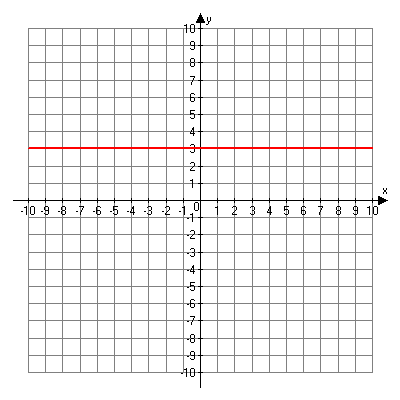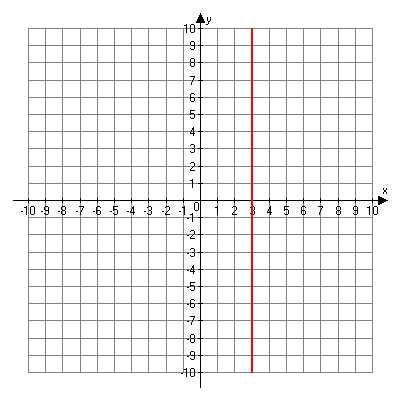Horizontal and Vertical Lines
There are two special kinds of lines that you need to be aware of when graphing linear equations and inequalities. These are vertical and horizontal lines. Look through the following sliders to learn more about these special lines and practice graphing them.
Let's first take a look at how you would create horizontal lines.
Horizontal lines are created when the slope of a line is equal to zero.

Graph of y = 3
This is a flat, horizontal line with no steepness. Therefore the slope is equal to zero. The equation of this graph is y = 3 because the graph is stuck at y = 3. It has many x-values, but only one y-value.
Take a look at the next three graphs and their equations. Notice that each graph is a horizontal line and it crosses the y-axis at the value given in the equation. Click on the equations below to view the graphs.
Now, let's look at how you would create vertical lines. Vertical lines are created when the slope of a line is undefined.

Graph of x = 3
This is a flat, vertical line with an undefined slope. The equation of this graph is x = 3 because the graph is stuck at x = 3. It has many y-values, but only one x-value.
Take a look at the next three graphs and their equations. Notice that each graph is a vertical line and it crosses the x-axis at the value given in the equation.
 Self-Check: Vertical and Horizontal Lines
Self-Check: Vertical and Horizontal Lines
Now you try. Complete the self-check activity by looking at each problem, thinking about it, and clicking on the problem to review the explanation.
Self Check items
x = 6
This is a horizontal line that crosses the y-axis at -7.
The red line is: x = -1.
The blue line is: y = 3.


The red line is: x = 1.
The blue line is: y = -4.
Use this worksheet to continue practicing writing and graphing horizontal and vertical lines. Once you have completed the worksheet, check your answers against the key.